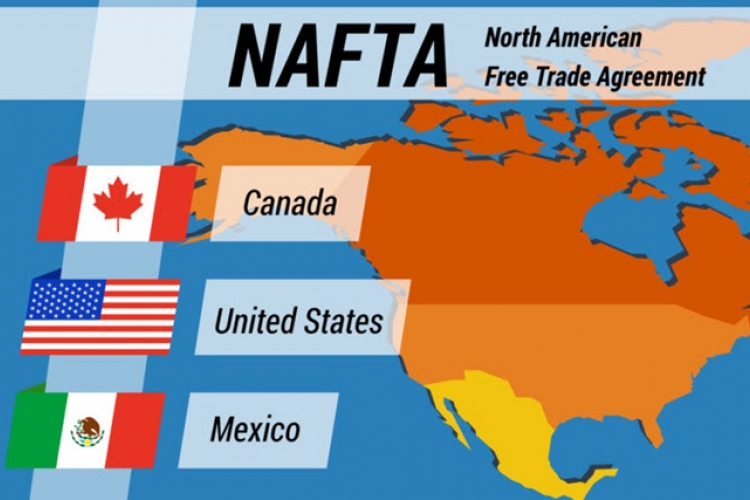RENEGOTIATION OF NAFTA
IN NEWS
The United States hopes to strike a quick bargain with Canada after reaching an agreement with Mexico this week on continent-wide trade.
NAFTA
NAFTA stands for the North American Free Trade Agreement to lift tariffs (taxes on imports and exports) on virtually all goods traded among the US, Canada, and Mexico.
NAFTA came into effect on January 1, 1994, after it was signed on December 17, 1992 by:
- US President George H.W. Bush
- Canadian Prime Minister Brian Mulroney
- Mexican President Carlos Salinas
Purpose of NAFTA
The aim of NAFTA was to make it easier for companies in the three countries to do business across borders.The argument for NAFTA was that - by boosting economic integration - there would be increased economic prosperity in all three countries.
Where it all started
US President Donald Trump, on the campaign trail, labelled NAFTA "the worst trade deal" ever signed by the US.Trump blames NAFTA for wiping out US manufacturing jobs because it allowed companies to move factories to Mexico where labour is cheaper.
In April 2017, US President threatened to pull out of the trade agreement. Canada and Mexico insisted to renegotiate it instead, and Trump agreed.
Mexico, along with Canada, has been targeted by the Trump administration with heavy tariffs on steel and aluminum. In retaliation, Mexico raised tariffs on products made in pro-Trump heartland states, such as steel, pork, fruit and cheese.
Can US pull out of NAFTA?
As per the NAFTA agreement, a country can withdraw from it after giving six months notice. In the US, Trump can set that in motion without congressional approval. In April he requested a renegotiation of the terms of the NAFTA agreement.
NAFTA's impact on Mexico and Canada
According to the Council on Foreign Relations (CFR), NAFTA gave a major boost to Mexican farm exports to the US, which have tripled since NAFTA's implementation. Hundreds of thousands of Mexican auto-manufacturing jobs have also been created, and most studies have found that the pact had a positive impact on Mexican productivity and consumer prices.
But there are significant downsides: Mexico's economy grew at an average rate of just 1.3 percent a year between 1993 and 2013 during a period when Latin America was undergoing a major expansion, and poverty remains at similar levels to 1994, while mass unemployment has increased.
Instead of fulfilling its promise of providing cheaper food to Mexicans, NAFTA deepened Mexico's dependency on food imports, leaving it unprotected from volatility in international food prices and exchange rates.Thousands of Mexican farmers and workers took to the streets demanding that NAFTA be abandoned. They argue that the deal has devastated Mexican small farms, which struggle to compete with US imports.
Canada has seen strong gains in cross-border investment in the NAFTA era.Since 1993, US and Mexican investments in Canada have tripled. Canadian agriculture, in particular, saw a boost, while employment in Canadian manufacturing held steady.
Competition from Chinese exports increased during the same time period and boomed as China joined the WTO in 2001. Economists are more united in the view that the US has lost more jobs to China than to Mexico
What does Trump want a new NAFTA to look like?
Reducing the U.S. trade deficit within NAFTA, which could mean increasing U.S. exports or reducing Canadian and Mexican imports.
Scrapping NAFTA’s dispute-resolution panels, which have sometimes ruled in Canada’s favour on softwood lumber and other trade issues.
Using “Buy American” provisions to bar Canadian or Mexican firms from seeking U.S. government contracts.
Dairy: The U.S. wants an end to Canada’s supply-management regime for dairy and poultry products.
Sunset clause: The U.S. wants the new NAFTA to expire in five years unless the member countries agree to renew it.
MEXICO ISSUE WITH NEW NAFTA
For Mexico, the biggest issue of the NAFTA talks has been auto manufacturing. The United States wanted new requirements that 40 to 45 per cent of auto content in the NAFTA zone be made at factories that pay US$15 an hour or more, which is more than four times what the average Mexican worker makes.
Mexico’s resistance to the auto proposal, which they fear would drive manufacturing jobs away from the country, kept the NAFTA negotiators at loggerheads for months, but on Aug. 27 Mr. Pena Nieto and Mr. Trump announced they had reached an “understanding” on the issue.
CANADA’S CONTENTIOUS TRADE ISSUES
Canada’s dairy, egg and poultry industries are governed by a supply-management system. It has three parts, Fixed prices, production quotas and tariffs to protect Canadian producers from foreign competition.
The dairy tariffs – which run up to 270 per cent, and which Canada tightened in 2016 to include unfiltered milk products used to make cheese and yogurt – have been a thorn in the side of other dairy-producing nations like the United States, Australia and New Zealand.


 "UPSC-2026-PRELIMS COMBINED MAINS FOUNDATION PROGRAMME" STARTS WITH ORIENTATION ON FEB-10
"UPSC-2026-PRELIMS COMBINED MAINS FOUNDATION PROGRAMME" STARTS WITH ORIENTATION ON FEB-10